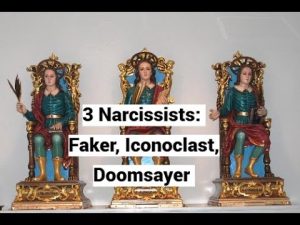How Narcissist Collapses Furiously
1. Definition and Nature of Narcissistic Collapse
- Narcissistic collapse is not solely caused by deficient narcissistic supply, although this is a contributing factor. It involves problems with self-regulation due to dependence on external regulation, leading to overwhelming shame and potential suicidal ideation. The narcissist may clinically resemble a borderline personality in this state [00:00].
- Another form of collapse happens when others refuse to participate in the narcissist’s shared fantasy, which organizes the narcissist’s life and provides meaning and purpose. The narcissist is captive to this fantasy, which is rooted in early childhood experiences [01:05].
2. Role of Shared Fantasy and Narcissistic Supply
- The narcissist requires others to collude in the shared fantasy for obtaining narcissistic supply. Rejection or refusal by others to participate results in collapse and feelings of injustice due to perceived entitlement [02:20].
- Narcissistic collapse involves a splitting defense mechanism where the narcissist views self as all good and others as all bad, leading to anger and aggression originating from a sense of being wronged [04:05].
3. Aggression and Internalization
- When external aggression toward others is ineffective or impossible, the narcissist internalizes this anger, directing it toward self, resulting in narratives of personal failure and unworthiness, which re-enact early childhood conditions where love was conditional on performance [06:10].
- Internalized aggression manifests as depression, self-harm, reckless behavior, and borderline personality features [06:50].
4. Hierarchy of Narcissistic Supply
- Narcissists have some capacity for self-supply, which can somewhat mitigate collapse by simulating external supply, as narcissists cannot distinguish internal from external sources [09:05].
- Low-grade or fake supply exacerbates collapse, increasing feelings of failure and unworthiness. Narcissists prefer high-grade (authentic) supply, self-supply next, and reject low-grade or fake supply [10:10].
5. Social Dynamics and Cycle of Hostility
- The narcissist’s demanding, entitled, and aggressive behavior often alienates others, leading to punishment or denial of narcissistic supply. This fuels a vicious cycle of resentment, hostility, and further collapse [11:35].
- Others’ punishment or denial, even when the narcissist succeeds at genuine accomplishments, plays into the narcissist’s alternative shared fantasy of self-destruction, recruiting people as “haters” or enemies [13:40].
6. Collapse Spiral and Interpersonal Conflict
- The collapse initiates a spiraling conflict where the narcissist lashes out at perceived enemies, fails to change behaviors, internalizes self-hatred, and continues to cycle through aggression and victimization endlessly [15:50].
- The narcissist’s need for supply leads him/her to seek new environments to temporarily restore narcissistic supply and grandiosity, thus repeating the cycle [18:20].
7. Complexity and Psychological Mechanisms
- Narcissistic collapse is complex, with multiple overlapping mechanisms including internal and external aggression, shifting shared fantasies, and persistent chaos due to the loss of organizing principles. The narcissist faces the painful reality of self and shame [19:30].
- Collapse results in heightened anxiety and depression, compounded by the narcissist’s compulsive but contradictory goals of punishing supply deniers while striving to recruit new sources of supply [21:25].
8. Life Span Considerations and Risks
- Narcissists experience multiple collapses over their lifespan, with increasing frequency and difficulty managing collapse as they age due to accumulated memories and depleted coping strategies [22:40].
- Severe or prolonged collapse can lead to borderline personality deterioration, severe depression, and serious suicidal ideation, representing life-threatening risks [23:50].






